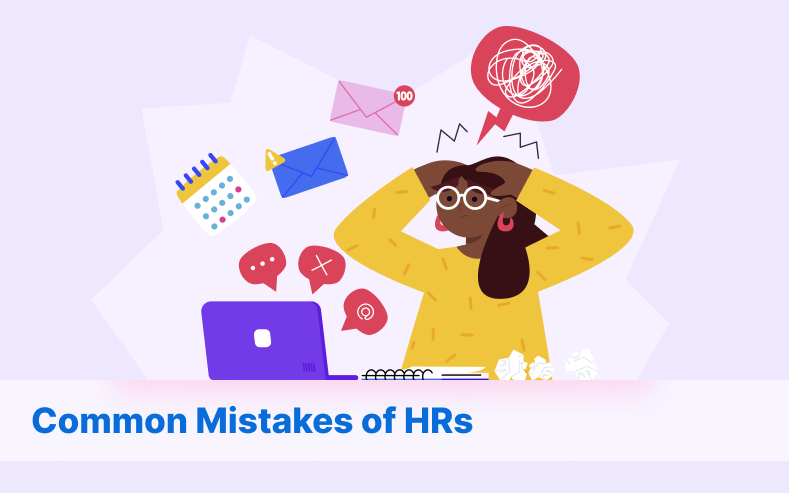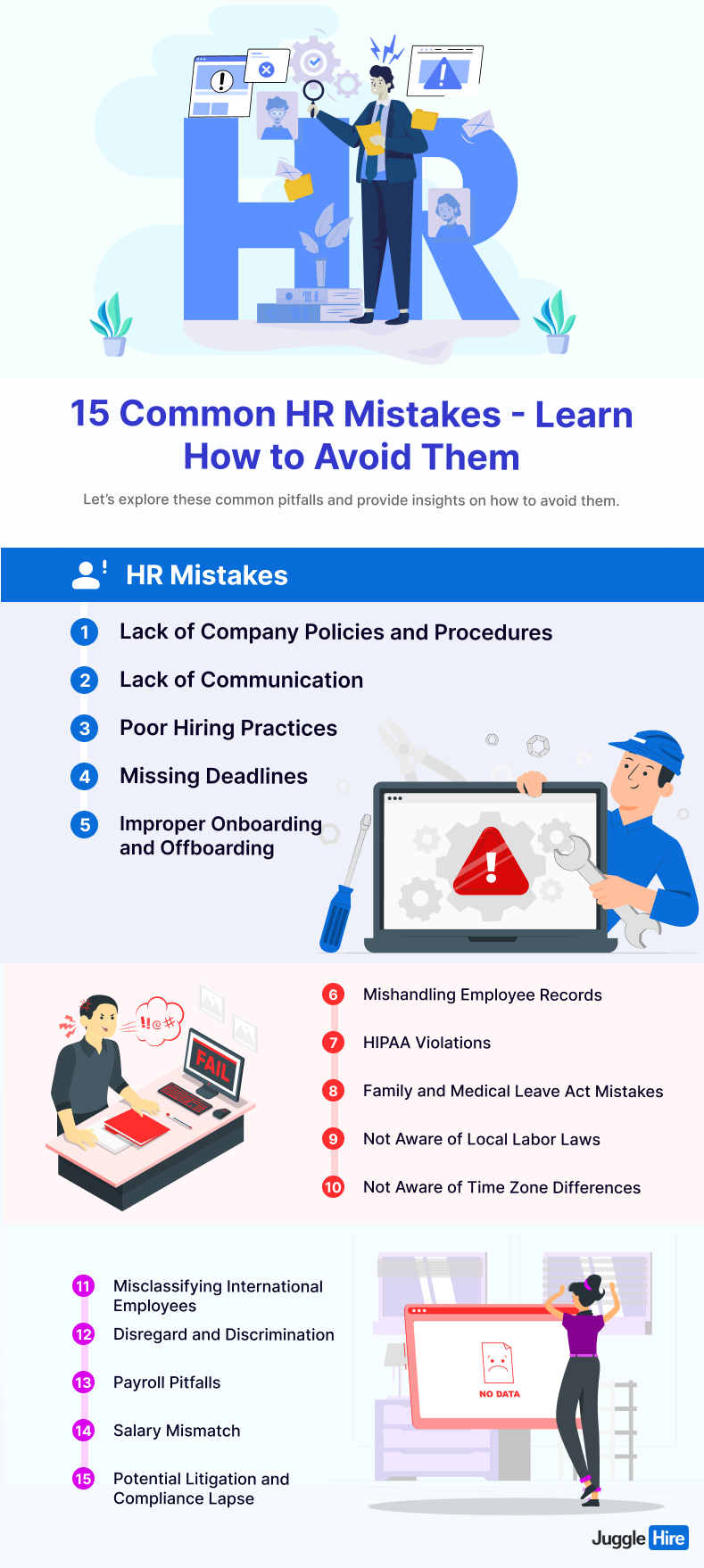10+ Common HR Mistakes that You Should Avoid (+Solutions)

Mistakes are not tolerable for HR managers and recruiters. For recruiting, mistakes are like ripples that can spread through a whole company. Eventually, this can affect the company’s vibe, atmosphere, and legal stuff.
For 67% of recruiters, the top hiring difficulty is a shortage of qualified candidates.
Devskiller
Since people are the core of Human Resources, it is super important to be proactive. That means spotting and fixing common HR mistakes before they become big headaches.
On that note, let’s talk about common HR mistakes, so folks in HR and businesses can avoid them.
Why You Need to Be Aware of the Common Mistakes of an HR

When you can address the common HR mistakes, you will have a secret weapon for hiring. HR managers must know how to dodge HR problems that could mess up their job atmosphere, coworkers, and even their company’s success.
Here are some crucial facts to be aware of the common HR mistakes:
- Mistakes in HR can affect the whole workplace culture and employee satisfaction, not just paperwork.
- Even small blunders like recruitment or communication slip-ups can cause major issues throughout the organization.
- By avoiding common HR errors, you can create a positive work environment.
- Preventing HR mistakes saves resources such as time, money, and effort that would otherwise be spent rectifying problems.
- Understanding common HR mistakes facilitates better communication between HR professionals and employees.
- Being aware of common HR mistakes can streamline the hiring process.
- A well-functioning HR department free from common mistakes allows employees to focus on their work.
These errors might seem small, but they can cause big problems. Understanding these goofs isn’t about blaming anyone. It is about making sure important HR stuff, like hiring the right people and keeping a positive work vibe, goes smoothly.
HR personnel can steer clear of the common HR mistakes by knowing them. So, they should create a workplace where employees perform well, rules are clear, and everyone’s on the same page.
In HR, knowing what can go wrong isn’t just a skill; it is like having a compass guiding you to a better work future.
Related –
Powerful Talent Acquisition Trends to Change the Hiring Game
15 Common HR Mistakes – Learn How to Avoid Them

One of the critical aspects of running a successful business is effective human resources management. However, several common HR mistakes can hinder organizational growth and employee satisfaction.
Let’s explore these common pitfalls and provide insights on how to avoid them.
01. Lack of Company Policies and Procedures
One of the most common HR mistakes is the absence of clear company policies and procedures. Employees need guidelines on how to navigate workplace situations and duties. This includes rules regarding –
- Cell phone use
- A code of conduct (including sexual harassment policies)
- Wage information
- Anti-discrimination policies
Failing to address these areas can lead to confusion and misunderstandings among employees.
Consequence of This Issue:
A company (not want to mention the name) failed to have clear guidelines on remote work expectations during the COVID-19 pandemic. As a result, some employees worked irregular hours. Eventually, it led to burnout and decreased productivity.
How to Solve This Issue:
To mitigate this issue, businesses should create comprehensive policies that cover all necessary aspects. Also, they should strongly communicate these policies with everyone. For that, they can create better communication channels.
To avoid this issue, companies should focus on establishing explicit remote work policies. They must outline expectations for work hours and performance evaluation.
02. Lack of Communication
Poor communication is a significant HR mistake that can lead to conflicts, misunderstandings, and reduced employee morale. HR professionals must prioritize effective communication by sharing information promptly and clearly.
Consequence of This Issue:
A particular manufacturing company underwent a restructuring. However, it didn’t adequately inform employees about the changes in their roles and responsibilities. This lack of communication caused confusion, resentment, and a decline in employee morale.
How to Solve This Issue:
To prevent this, the company could have held regular meetings to discuss the restructuring plans. It could have provided opportunities for employees to ask questions. More importantly, it should offer support and training for those transitioning to new roles.
Overall, companies must implement an open-door policy. This will result in a culture where employees feel comfortable approaching management for assistance and feedback. They must provide channels for feedback. This will contribute to an open and transparent communication environment within the organization.
03. Poor Hiring Practices
One of the most detrimental HR mistakes is making poor hiring decisions. Ineffective interviews and assessments can result in hiring the wrong candidates. This can result in decreased productivity, increased turnover, and negative team dynamics.
Poor hiring decisions can also damage a company’s reputation, making it more challenging to attract top talent in the future.
Consequence of This Issue:
Without conducting thorough interviews or assessing their technical skills properly, a tech startup rushed to hire software developers. As a result, several hires were unable to meet job requirements. Gradually, they had to spend more. Their projects were delayed, which is the worst part.
How to Solve This Issue:
To avoid this, HR professionals should establish a clear and structured hiring process. To evaluate a candidate’s skills and cultural fit, they should utilize the following in their hiring methods –
- Creating detailed job descriptions
- Conducting comprehensive interviews
- Checking references
- Using pre-employment assessments
A robust hiring process ensures that businesses bring in candidates who align with the organization’s values. Hence, the selected candidates will contribute positively to the team.
04. Missing Deadlines
Overlooking legal deadlines, such as tax forms, vendor payments, and regulatory filings, is a common HR problem. Fines for late filings can be expensive and complicated, negatively impacting the business. Implementing a reliable system to consistently meet all deadlines is crucial for legal compliance.
Consequence of This Issue:
An advertising agency was dealing with poor time management and inadequate resource allocation. As a result, it consistently failed to meet project deadlines. This resulted in client dissatisfaction and the loss of several key accounts.
How to Solve This Issue:
The agency could have prevented this by implementing project management tools. Then, it would be easier for them to set realistic timelines. In addition, they should regularly monitor progress to ensure the timely delivery of projects.
Moreover, companies can consider partnering with a Professional Employer Organization (PEO). This approach will ensure meticulous adherence to rules and regulations. It can prevent the business from missing important deadlines and facing potential financial consequences.
05. Improper Onboarding and Offboarding
One of the most frequent HR mistakes is neglecting the onboarding and offboarding processes. A smooth onboarding process is essential for new employee success, preventing stress or a sense of directionlessness that may lead to early departures.
A good onboarding process introduces new hires to company values, culture, policies, and the overall mission. Equipping them with the necessary tools and introducing them to colleagues helps create a positive and comfortable start.
Consequence of This Issue:
We were able to get in touch with a retail chain company. Once, it neglected to provide proper onboarding training for new hires. As a consequence, the employees were suffering from a lack of product knowledge and customer service skills.
Moreover, during offboarding, they could not handle sensitive customer data. It resulted in a data breach.
How to Solve This Issue:
To address these issues, the company should have implemented structured onboarding programs. Plus, it should have provided comprehensive training modules and clear protocols for handling customer data during offboarding.
Setting up organized procedures for offboarding is important. An offboarding checklist ensures that necessary steps are not overlooked. It will maintain a smooth transition for departing employees.
06. Mishandling Employee Records
Employee records contain sensitive information. Employers may fail to comply with data protection regulations, such as the General Data Protection Regulation (GDPR) and the Health Insurance Portability and Accountability Act (HIPAA). This can result in breaches of confidentiality and privacy laws.
Employers should know that retaliation, disability, race, and sex discrimination are frequently filed charges with the Equal Employment Opportunity Commission (EEOC).
Consequence of This Issue:
A healthcare organization in Chillie was tricked. It inadvertently shared employee records with unauthorized individuals. In return, it experienced a data breach due to lax data security measures. The records contained medical histories and personal information.
How to Solve This Issue:
To prevent such breaches, the organization should have implemented encryption protocols and restricted access to sensitive data. Additionally, they should have provided thorough training on data security practices for employees handling confidential information.
To counter claims, businesses must maintain proper documentation. They must keep track of documents on performance improvement plans, disciplinary actions, and policy violations. This will ensure transparency and legitimacy in addressing employee-related issues.
07. HIPAA Violations
The Health Insurance Portability and Accountability Act (HIPAA) sets national standards for the protection of sensitive patient health information. Unfortunately, violating these guidelines is a common HR mistake.
HIPAA governs the protection of Protected Health Information (PHI).
Violations can result in severe penalties. These include fines of up to $50,000 per violation and criminal charges for willful neglect of patient privacy.
Consequence of This Issue:
Similar to the previous incident, a healthcare provider disclosed patients’ medical records to unauthorized individuals without concern. It is their failure to implement proper encryption measures for electronic records. This violation of HIPAA regulations resulted in significant fines and damaged the organization’s reputation.
How to Solve This Issue:
To prevent HIPAA violations, healthcare organizations should –
- Implement robust data encryption protocols
- Restrict access to patient records to authorized personnel only
- Provide regular training on HIPAA compliance for all employees
To safeguard PHI, organizations should strictly adhere to HIPAA requirements. Only then, they can avoid accidental disclosures and legal consequences.
08. Family and Medical Leave Act Mistakes
The Family and Medical Leave Act (FMLA) provides eligible employees with up to 12 weeks of unpaid, job-protected leave for qualifying family and medical reasons. Yet, maintaining this act can be challenging for HR departments. They may fail to inform employees of their rights under FMLA.
What’s more, there can be a lack of necessary forms and information to request leave. Terminating an employee based on FMLA-covered leave can lead to legal issues with a two-year statute of limitations.
Consequence of This Issue:
In the beginning, a manufacturing company was unaware of employee’s rights under the Family and Medical Leave Act (FMLA). Hence, the company denied an employee’s request for medical leave to care for a family member. This led to a legal dispute and potential penalties for non-compliance with FMLA regulations.
How to Solve This Issue:
Employers should familiarize themselves with FMLA regulations. Usually, this includes the following –
- Eligible reasons for leave
- Duration of leave
- Employee rights
On top of that, employers should implement clear policies and procedures for requesting and approving FMLA leave. They need to audit absences during termination discussions. In this regard, they can also provide training for HR staff. This is how companies can avoid potential legal complications.
09. Not Aware of Local Labor Laws
Labor laws are related to minimum wage, overtime pay, employee rights, and workplace safety. However, failing to stay informed about local labor laws is one of the common HR mistakes.
Employment laws change frequently and vary across countries, making it challenging for HR teams to keep up. Ignorance of labor laws is not a defense against violations. Employers can face fines, penalties, and lawsuits for non-compliance.
Consequence of This Issue:
While expanding operations to a new country, multinational corporations should never fail to familiarize themselves with local labor laws. HR managers should be aware of the minimum wage, working hours, and employee rights. Failing to do so will result in violations of labor laws. Further, this will result in fines and reputational damage.
How to Solve This Issue:
Before expanding into a new jurisdiction, companies should conduct thorough research on local labor laws and regulations. They can seek legal advice if necessary. Moreover, they can establish HR policies and practices according to local requirements. This will mitigate risks.
What’s more, they can also collaborate with in-country legal and HR experts. They can navigate the intricacies of local legislation, especially in multiple regions. Ultimately, this will ensure compliance and protect the company from potential litigation.

10. Not Aware of Time Zone Differences
In a globalized workplace, overlooking time zone differences can lead to missed deadlines and project delays. HR professionals must factor in time zones when scheduling company-wide meetings. They should consider that some employees may be finishing their workday while others are just starting.
Consequence of This Issue:
A global software development team (not mentioning the name) didn’t account for time zone differences when scheduling meetings and coordinating work tasks. They experienced communication breakdowns as a result of this. So, they continuously missed project deadlines. Ultimately, their productivity was decreased.
How to Solve This Issue:
Companies with distributed teams should implement tools and processes to manage time zone differences effectively. The following approaches will minimize disruptions and maximize productivity –
- Using scheduling software that displays multiple time zones
- Establishing standardized meeting times
- Fostering a culture of clear communication and collaboration across time zones
11. Misclassifying International Employees
Understanding the differences between independent contractors and employees is crucial to avoid misclassification. HR must grasp local government definitions of employees to prevent unintentional violations that can lead to severe penalties. Awareness and adherence to local regulations are essential when managing international employees.
Consequence of This Issue:
A company classified international remote workers as independent contractors rather than employees. The HR managers were not aware that it was an act of violation of labor laws in the workers’ home countries. This act led to potential tax liabilities for both the employees and the company.
How to Solve This Issue:
As said earlier, companies should seek legal advice to understand the employment laws. Plus, they should obey tax regulations in the countries where their international employees are based. According to the nature of their relationship, they should accurately classify workers as employees or contractors. This is how they can avoid these common HR mistakes.
12. Disregard and Discrimination
Maintaining professionalism and avoiding favoritism based on factors like origin, gender, or race is crucial for a fair workplace. Employees should feel heard, and their concerns addressed to foster a positive atmosphere.
Consequence of This Issue:
An HR representative of Weston Homes consistently overlooks qualified candidates from underrepresented groups during the hiring process. It resulted in a lack of diversity within the organization. They paid £14,000 in legal compensation for discrimination.
How to Solve This Issue:
Employers must prioritize diversity and inclusion efforts throughout the entire employee lifecycle. Any form of harassment must be strictly prohibited. Plus, swift actions should be taken to address discrimination. Building an inclusive environment can prevent discrimination and promote a diverse workforce.
13. Payroll Pitfalls
Employee pay lawsuits have surged in the past decade. Often, it happens due to improper classification and failure to pay overtime wages. Correct classification under the Fair Labor Standards Act is essential, and job titles alone do not determine exempt status.
Misclassification of gig workers is another potential pitfall. It requires careful evaluation based on IRS guidelines. However, not all recruiters or HR professionals have sufficient skills on this topic.
Consequence of This Issue:
Often, employers deal with incorrect calculations of overtime pay or deductions. These are common payroll errors. When a company experiences these errors, it will face employee dissatisfaction, compliance issues, and potential legal action for wage violations.
How to Solve This Issue:
HR professionals must comply with payroll regulations. It is crucial to avoid legal complications and financial losses. With that said, employers should establish transparent and equitable salary structures. To do that, they can focus on job responsibilities, experience, and performance, rather than non-job-related characteristics.
14. Salary Mismatch
Improper salary management can lead to serious consequences, including overpaying or underpaying employees, impacting both individual finances and company budgets. Utilizing software-generated payrolls can streamline payment processes, reducing errors.
Consequence of This Issue:
In some cases, an employer may offer different salaries to employees performing similar roles. It can be made based on factors such as gender or race. This can create disparities in pay. In addition, the employer may charged with legal action for wage discrimination.
How to Solve This Issue:
Regular updates on the total cost of salaries can provide transparency. Also, it can aid in financial planning. Moreover, companies must avoid freezing wages as a punitive measure, as it goes against professionalism and fair employment practices.
15. Potential Litigation and Compliance Lapse
Keeping up with changing regulations at the state and national levels is essential to avoid potential litigation. HR teams should proactively communicate key changes to managers and employees.
Consequence of This Issue:
Companies must adhere to employment laws and regulations. They should not fail to ensure workplace safety or harassment prevention. If so, they may experience employee lawsuits, regulatory fines, and reputational damage.
How to Solve This Issue:
Companies can provide training for employees and managers on their rights and responsibilities. They should conduct regular compliance audits and promptly address any issues that arise. In the event of an accusation, prompt investigation and interviews with relevant parties are crucial. These practices can maintain a positive workplace culture.
Since you have learned the common HR mistakes, you should be interested in –
Common recruitment challenges and how to overcome them
HR Mistakes and Their Costs

HR mistakes can have far-reaching consequences for businesses, impacting various aspects and incurring significant costs. From legal challenges to recruitment expenses, these common HR problems can pose financial risks and affect the overall well-being of the company.
Litigation Costs:
Failing to comply with federal and state labor regulations or ensure data privacy can result in substantial litigation costs. Small and midsized businesses may face defense and settlement costs averaging hundreds of thousands of dollars.
An analysis of 1,214 closed claims from businesses with fewer than 500 employees revealed that 24% of employment charges incurred an average cost of $160,000 and took about 318 days to resolve.
Hiring the Wrong Employee:
Selecting the wrong candidate for a job introduces risks that can be costly for the company. Beyond the direct expenses associated with recruiting and training, the indirect costs of a misfit employee can be substantial.
Ensuring a thorough and effective hiring process is crucial to minimizing the risks and expenses associated with bringing the wrong person on board.
Onboarding Expenses:
Onboarding new employees comes with an average cost of $4,129 each. This includes expenses related to orientation, training, and integrating new hires into the company culture.
Implementing effective policies, clear communication on expectations, and adherence to legal requirements can contribute to employee retention, ensuring that the investment in onboarding pays off over the long term.
FAQs on Common HR Mistakes
What is HR agility?
HR agility is the ability of Human Resources teams to respond quickly and effectively to changes and disruptions. It means being nimble, proactive, and responsive, especially during challenging times like the ongoing pandemic.
What are bad HR practices examples?
Some examples of bad HR practices include:
- Failing to hire for fit.
- Conducting poor interviews.
- Expecting employees to act like owners without proper support.
- Promoting individuals to management solely based on seniority.
- Providing no training for new employees.
- Neglecting performance management.
- Retaining poor-performing employees.
- Lack of organizational structure.
What is the biggest problem in HR?
In HR, the biggest challenges revolve around talent acquisition and retention, boosting employee engagement, and managing diversity. With 51% of employees feeling disengaged and 13% actively disengaged, addressing these areas becomes crucial for the overall success of the HR department.
Bottom Line
In navigating the intricate landscape of HR, the key to steering clear of common pitfalls is to collaborate with seasoned experts. By using an effective hiring solution such as JuggleHire, businesses gain access to a dedicated team of HR professionals and employment lawyers.
This partnership will ensure meticulous handling of payroll taxes, benefits, and employee data. Plus, it will allow businesses to focus on growth, unburdened by concerns about potential HR missteps. Remember, in HR, the right support is not just a luxury; it’s a strategic necessity for sustainable success.

I don’t think the title of your article matches the content lol. Just kidding, mainly because I had some doubts after reading the article.
Thanks for your comment 🙂
Can you mention the company name for the 1st HR mistake, which is “Lack of Company Policies and Procedures”?
I am terribly sorry.. but it is out of our policy.
Great! Finally, found some useful tips to share with my colleagues.
Glad to help Mike